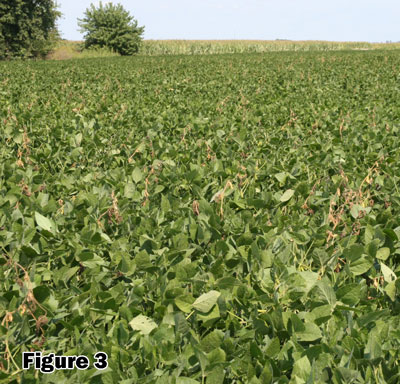
- Two different types of stem canker can be found in Illinois and Wisconsin; northern stem canker and southern stem canker.
- Northern stem canker is most prevalent throughout the Northern regions.
- Symptoms of stem canker can be confused with Phytophthora stem rot. However, stem canker has green stem tissue below and above the canker and does not cause root rot.
- Susceptible cultivars growing in environments conducive to stem canker development can have up to 50% yield losses.
- Management options are limited and include resistant variety selection, crop rotation to non-host crops and deep plowing.
Biology and Life cycle
Two types of stem canker have been found in IL and WI. Northern stem canker (Diaporthe phaseolorum var. caulivora) and southern stem canker (D. phaseolorum var. meridionalis). The causal fungi can survive in infested residue or in the soil for several years. Seeds can also be infected although this is not the primary source of infection. The optimum environment for disease development varies for each type of stem canker. Northern stem canker is associated with cooler temperatures and extended periods of wet weather. Southern stem canker requires 24-96 hours of leaf wetness and warm temperatures.
In late winter pycnidia (fruiting bodies) begin to develop and spores are released during late April-June. Infection occurs when spores are splashed onto plant tissue during rainy weather when soybeans are in the vegetative stages. However symptoms are not observed until after flowering when soybeans enter the reproductive stages. If the environment is conducive to infection there can be secondary spore production, but these later infections will not have a significant impact on soybean yields. However, they can increase the source of inoculum for the next growing season.
Symptoms
Initial symptoms are reddish-brown lesions that appear near the nodes (Fig. 1) and eventually turn into sunken, dark brown cankers that expand longitudinally (Fig. 2). Stem canker can be confused with Phytophtora stem rot, but stem canker typically has green tissue above and below the canker (Fig. 2) and does not cause root rot. Plant parts above the lesions may die resulting in a shepherd's crook curling of the terminal bud (Fig. 3). Keep in mind that sometimes a plant may be infected without any of these symptoms being evident. Foliar symptoms may also be observed as interveinal chlorosis and necrosis similar to sudden death syndrome (SDS) and brown stem rot (BSR). However SDS will not have a stem lesion as stem canker infected plants do and as SDS disease progresses, leaves will curl and drop off while stem canker dead leaves will remain attached to the plant (Fig. 3). Compared to BSR the main difference will be visible in the stem which when split open will show discolored piths in BSR infected plants.
More information on how to distinguish stem canker from other diseases can be found at: http://www.soybeanresearchinfo.com/pdf_docs/StemCanker_CPN1006.pdf
Management
Unfortunately, there are not effective chemical tools available to manage stem canker. Some literature pieces will mention "fungicides" but they may only reduce disease severity when combined with resistant varieties and when applied early. Even when moderately effective, fungicides will not control infections already present in the field and originated from the soil or crop residue. Some articles also indicate that "seed treatments" can reduce stem canker and although there is ongoing research looking at seed treatments as potential management tools, there is not enough efficacy data available to date.
The best way to manage stem canker is using a combination of cultural practices and resistant varieties. In fields with a history of stem canker, consider planting a resistant variety (check with your seed dealer on what resistant varieties may be available in your area). Since the fungus can survive in the soil and crop residue, deep plowing may help reduce the source of inoculum. To avoid movement of infested residue to clean fields, consider plowing infested fields last. In addition, seed that is used for seed production should not be harvested from fields with a known history of stem canker as this disease can also be seed transmitted.
Rotating soybean fields to non-host crops such as corn, wheat and sorghum are recommended to reduce the amount of inoculum available to infect the next soybean crop. However, because the fungus can survive in the soil for several years, long rotations (two years or more) are recommended especially after heavy stem canker infestations.
Contact your FS Crop Specialist for your agronomic information.


Figure 1: Early stem canker lesion near a node. (Source: GROWMARK, Inc.)
FIgure 2: Stem canker lesions. Note the sunken appearance and longitudinal expansion with green tissue below and above the canker. (Source: lsuagcenter.com)
Figure 3: Top dieback caused by Diaporthe spp. Note that the dead leaves are attached to the plant. (Source: GROWMARK, Inc.)